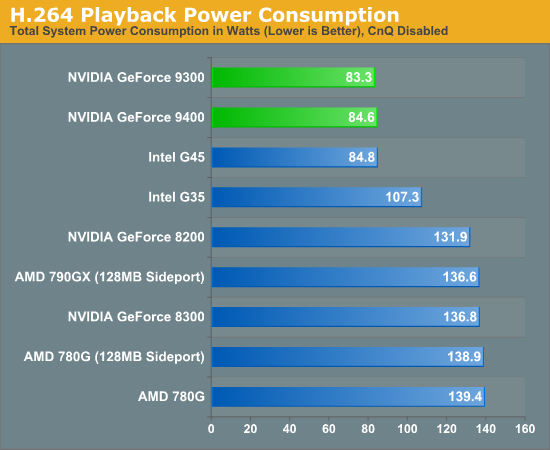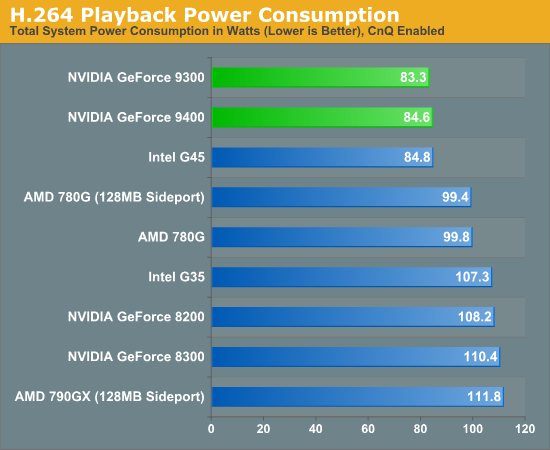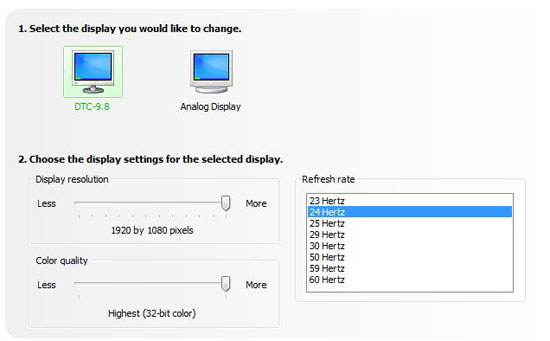The IGP Chronicles Part 3: NVIDIA's GeForce 9300
by Anand Lal Shimpi & Gary Key on October 15, 2008 12:00 AM EST- Posted in
- Motherboards
Blu-ray Power Consumption
Since we're dealing with an Intel platform from NVIDIA, the Cool'n'Quiet issues we mentioned in our previous article don't apply here. You simply get the best combination of low CPU utilization and very low power consumption when watching HD content:


So far so good; we don't have any HDMI incompatibilities, no repeater issues to report, the GeForce 9300 just worked in all of our home theater setups. But how about the more niche features?
8-channel LPCM support comes natively with the GeForce 9300 and like on the Radeon HD 4xxx series, it just works. NVIDIA's platform drivers include an HDMI audio driver that, once installed, allows you to configure your audio output as 2, 6 or 8 channels. Of course bitstreaming both Dolby Digital and DTS audio is supported. Unfortunately, as we've mentioned before, there is no support for bitstreaming Dolby TrueHD or DTS-HD MA; you'll need to wait until sometime next year before you get full support there.
As we mentioned in our last article, proper 24Hz refresh rate support is particularly useful for playing back 24 fps content (which happens to be most movie content). Intel offers no support for 24Hz/24fps playback, AMD's implementation is a bit flaky, but NVIDIA's works flawlessly (at least with our test subjects). When connected to a display that supports a 24Hz input signal the option appears in the driver; just select it and you're good to go. The result is silky smooth playback of video content and it's nice.

Short of TrueHD/DTS-HD MA support, NVIDIA's GeForce 9300 is the perfect HTPC chipset. The NVIDIA control panel even offers more post processing customization options than both AMD and Intel, although we're thankful that NVIDIA disables all of the features by default. Honestly the only other complaint we have is that we need to have a monitor hooked up to the system to first get it installed in our home theater setup; once properly configured it worked flawlessly with our Integra DTC-9.8 pre-processor and JVC DLA-RS2 projector setup. There is still need for improvement on the software side to enable users to build a computer and simply plug it into a HT setup without a monitor and have it work.
Good job NVIDIA, here's your crown. (Care for a service plan with that?)










47 Comments
View All Comments
Badkarma - Wednesday, October 15, 2008 - link
Why would it be impossible to stream media? Most media streams are only a fraction of 100Mbit ethernet, even a full Blu-ray disc rarely hits 20+Mbit. The CPU usage charts for network traffic in this review are for full thoroughput tests, the NIC will never come close to pushing that much traffic when streaming media.Zstream - Wednesday, October 15, 2008 - link
I stream 300mbs/sec all the time on my HTPC with my gig Intel nic. I guess you never streamed across multiple devices. It is called VOD, if you do not believe me look at the newest tivo.R3MF - Wednesday, October 15, 2008 - link
Is this the chipset that nvidia is supposed to have worked with Via on to ensure Nano support?A HP mininote v2 using Nano and this mGPU would be an awesome product that would take a dump on every other netbook from a great height!
Hlafordlaes - Wednesday, October 15, 2008 - link
That's my understanding, too. I was wondering what the delay was caused by, now my guess is that Apple wanted the exclusive for launch. Let's hope some new mini-ITX 2.0 Nano boards with this chipset will appear soon.R3MF - Wednesday, October 15, 2008 - link
A lot of netbook newsites are reporting drastic price cuts in the mininote 2133, which is fueling speculation that a v2 may be due out soon.As it happens; there is already a petition requesting HP use the Nano + MCP79 combo in a future v2 mininote:
http://www.petitiononline.com/mininote/petition.ht...">http://www.petitiononline.com/mininote/petition.ht...
R3MF - Wednesday, October 15, 2008 - link
This chipset in ULV form is the one being used in the new MacbookAir, so there is no reason why it couldn't be used in netbooks like the HP Mininote, as adequately demonstrated in the power consumption page of this preview.R3MF - Thursday, October 16, 2008 - link
Do you have any thoughts or speculations you would like to share on whether this is the fabled Via Nano integrated chipset?It would be big news for those of us awaiting a powerful HP mininote v2..........